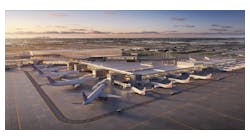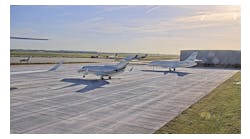Nothing puts a damper on airline travel plans faster than some talk about shoulder-launched missiles.
Travelers would rather not think about it. Even though the U.S. Department of Homeland Security is putting millions of dollars into the development of on-board missile-defense systems for the nation's domestic fleet of passenger planes, it hasn't identified a way to pay for them.
But the day is coming when commercial jets will have such systems, and Alliant Techsystems wants its product to be the system of choice.
Among the Edina-based defense contractor's long list of products is a missile-defense system. It detects shoulder-launched missiles fired from the ground and automatically shoots flares away from the aircraft to fool the heat-seeking missiles into shooting down a flare instead of the plane.
Alliant Techsystems' missile-defense equipment is being used on 1,000 cargo and troop planes and helicopters in Iraq and Afghanistan.
Testimonials from the U.S. Marine Corps say the system saved 20 aircraft in Iraq last year. Getting its product installed on commercial jetliners, at roughly $500,000 per plane, would be a financial windfall for Alliant Techsystems.
But landing that type of contract is anything but simple.
The Homeland Security Department is developing a system for commercial aircraft that uses lasers to disable the incoming missiles. Defense contractors Northrop Grumman and BAE Systems are competing to build the device. The systems are scheduled for preliminary tests by the end of this year.
A third team that included Alliant Techsystems and United Airlines had proposed the flare-based system for commercial jets. But Homeland Security decided last year that it wasn't convinced the team could meet the 18-month time frame to develop a prototype.
So far, Homeland Security has invested $120 million in the laser-based systems, and it could turn into a $10 billion project if it gets to the point of installing the technology on all commercial jets.
"We're frankly disappointed with that because we've got the only proven system," said Bryce Hallowell, a spokesman for Alliant Techsystems. "We're saving aircraft now."
While the flare-based system has apparently been passed over for commercial aircraft, it remains popular with the military.
In March, Alliant Techsystems received another $23 million contract from the military to equip additional planes and helicopters with its missile-warning system.
Missile attacks on commercial aircraft remain rare. In Kenya in 2002, two missiles were fired at a Boeing 757 that was an Israeli charter. Both missiles missed. Last November, a missile hit an Airbus A300 cargo plane as it took off from the Baghdad airport. The plane, which is in DHL's package-delivery fleet, was able to make an emergency landing even though it lost hydraulic power.
So what's wrong with the relatively low-tech flare-based system?
"They initially have something of a giggle factor to them," said John Pike, director of a Virginia-based military studies group called Globalsecurity.org. "When people think of flares they think they'll light up the skies like the Fourth of July, and worry they could start fires when they hit the ground."
Flare systems have registered false alarms, he said, and some worry that the flares shooting away from the planes would scare passengers.
False alarms with any type of missile-defense system are a major concern, Pike said, "because the way that Homeland Security considers the architecture, if an airplane feels it's being attacked, it also notifies the airport at which point the airport shuts down."
If such false-positive attacks were to occur even occasionally in the United States, it could cause bedlam for flight schedules, passengers' general sense of safety and the economic health of the already-battered airline industry, critics say.
Still, Pike is critical of the government for its seeming lack of urgency to get missile-defense systems installed on commercial jets. He thinks the military should take a longer look at the flare system, which is tested and available. While there's debate about how likely such a missile attack is in the United States, it would only take one and even a miss at that to prompt an outcry for protection, he said.
"They're trying to get something that's perfect, that's foolproof," Pike said. "That's not going to be deployed anytime soon."




